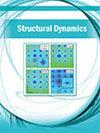用核价瞬态吸收光谱探测溴仿紫外光化学中超快C-Br键裂变
IF 2.3
2区 物理与天体物理
Q3 CHEMISTRY, PHYSICAL
引用次数: 14
摘要
采用紫外泵浦-极紫外(XUV)探针飞秒瞬态吸收光谱研究了溴仿(CHBr3)在268 nm诱导下的光解动力学。Br(3d)吸收边(~ 70 eV)的核价跃迁提供了反应的原子尺度视角,对局部价电子结构的变化敏感,具有超快的时间分辨率。XUV光谱跟踪了瞬态电子态的单占据分子轨道如何在C-Br键裂变过程中发展,最终形成自由基Br和CHBr2产物。对从激发态分子动力学模拟中得到的瞬态原子排列进行了互补的从头计算。C-Br裂变沿着近似CS对称的反应路径,导致电子轨道特征和原子排列的连续变化。两个时间尺度主导了瞬态吸收光谱的变化,反映了轻的C、H原子和重的Br原子的不同特征运动。在前40秒内,由于(光)CH部分的位移,从C3v对称畸变形成准平面CHBr2,导致价电子结构发生显著变化。(重)Br原子的位移被延迟,形成单独的Br + CHBr2产物需要长达~ 300 fs。我们证明了由XUV吸收产生的价激发(初始)和价+核激发(最终)态电子构型之间的跃迁对键裂变过程中价轨道的局域化很敏感。价电子-核空穴相互作用的变化为键解理过程中的谱移提供了物理解释。本文章由计算机程序翻译,如有差异,请以英文原文为准。
Probing ultrafast C–Br bond fission in the UV photochemistry of bromoform with core-to-valence transient absorption spectroscopy
UV pump–extreme UV (XUV) probe femtosecond transient absorption spectroscopy is used to study the 268 nm induced photodissociation dynamics of bromoform (CHBr3). Core-to-valence transitions at the Br(3d) absorption edge (∼70 eV) provide an atomic scale perspective of the reaction, sensitive to changes in the local valence electronic structure, with ultrafast time resolution. The XUV spectra track how the singly occupied molecular orbitals of transient electronic states develop throughout the C–Br bond fission, eventually forming radical Br and CHBr2 products. Complementary ab initio calculations of XUV spectral fingerprints are performed for transient atomic arrangements obtained from sampling excited-state molecular dynamics simulations. C–Br fission along an approximately CS symmetrical reaction pathway leads to a continuous change of electronic orbital characters and atomic arrangements. Two timescales dominate changes in the transient absorption spectra, reflecting the different characteristic motions of the light C and H atoms and the heavy Br atoms. Within the first 40 fs, distortion from C3v symmetry to form a quasiplanar CHBr2 by the displacement of the (light) CH moiety causes significant changes to the valence electronic structure. Displacement of the (heavy) Br atoms is delayed and requires up to ∼300 fs to form separate Br + CHBr2 products. We demonstrate that transitions between the valence-excited (initial) and valence + core-excited (final) state electronic configurations produced by XUV absorption are sensitive to the localization of valence orbitals during bond fission. The change in valence electron-core hole interaction provides a physical explanation for spectral shifts during the process of bond cleavage.
求助全文
通过发布文献求助,成功后即可免费获取论文全文。
去求助
来源期刊

Structural Dynamics-Us
CHEMISTRY, PHYSICALPHYSICS, ATOMIC, MOLECU-PHYSICS, ATOMIC, MOLECULAR & CHEMICAL
CiteScore
5.50
自引率
3.60%
发文量
24
审稿时长
16 weeks
期刊介绍:
Structural Dynamics focuses on the recent developments in experimental and theoretical methods and techniques that allow a visualization of the electronic and geometric structural changes in real time of chemical, biological, and condensed-matter systems. The community of scientists and engineers working on structural dynamics in such diverse systems often use similar instrumentation and methods.
The journal welcomes articles dealing with fundamental problems of electronic and structural dynamics that are tackled by new methods, such as:
Time-resolved X-ray and electron diffraction and scattering,
Coherent diffractive imaging,
Time-resolved X-ray spectroscopies (absorption, emission, resonant inelastic scattering, etc.),
Time-resolved electron energy loss spectroscopy (EELS) and electron microscopy,
Time-resolved photoelectron spectroscopies (UPS, XPS, ARPES, etc.),
Multidimensional spectroscopies in the infrared, the visible and the ultraviolet,
Nonlinear spectroscopies in the VUV, the soft and the hard X-ray domains,
Theory and computational methods and algorithms for the analysis and description of structuraldynamics and their associated experimental signals.
These new methods are enabled by new instrumentation, such as:
X-ray free electron lasers, which provide flux, coherence, and time resolution,
New sources of ultrashort electron pulses,
New sources of ultrashort vacuum ultraviolet (VUV) to hard X-ray pulses, such as high-harmonic generation (HHG) sources or plasma-based sources,
New sources of ultrashort infrared and terahertz (THz) radiation,
New detectors for X-rays and electrons,
New sample handling and delivery schemes,
New computational capabilities.
 求助内容:
求助内容: 应助结果提醒方式:
应助结果提醒方式:


